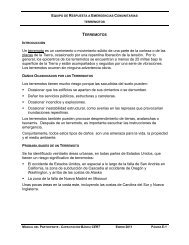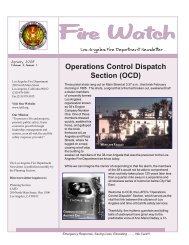FAMILY STEPS TO SURVIVAL - CERT Los Angeles
FAMILY STEPS TO SURVIVAL - CERT Los Angeles
FAMILY STEPS TO SURVIVAL - CERT Los Angeles
Create successful ePaper yourself
Turn your PDF publications into a flip-book with our unique Google optimized e-Paper software.
Learn what earthquakes are and what causes them.<br />
Explain why the ground and buildings shake. Go to a<br />
museum, a theme park or an expo that has an earthquake<br />
simulator so everyone can experience the shaking sensation.<br />
Remind everyone that the shaking will stop. Read stories or<br />
sing songs and let your children ask questions. Learn the<br />
difference between fact and fiction.<br />
Discuss aftershocks. Talk about the possibility that<br />
aftershocks as strong as the earthquake itself might occur<br />
and continue for some time. Make sure everyone<br />
understands that aftershocks are normal.<br />
Assemble children’s emergency kits. Help your children<br />
to assemble their own emergency kits. Include a note from<br />
parents, a special toy, family photograph and treat, as well<br />
as water, food and other emergency supplies. Kits should<br />
meet their needs and likes. Remember, no supplies are<br />
“wrong.”<br />
Accustom everyone to living without electricity. Go<br />
through an entire evening without using electricity to prepare<br />
everyone—especially children—for the possibility of having<br />
to live without it. Conduct a “flashlight” walk around the block;<br />
hold a candlelight or “flashlight” dinner; tell stories instead of<br />
watching television.<br />
ESP <strong>FAMILY</strong> S TEPS <strong>TO</strong> S URVIVAL / S TEP 9 , S IDE 2<br />
Coloring Page<br />
“I’m disaster prepared!”<br />
Draw a picture of you with your emergency supplies.<br />
After a disaster or major emergency, monitor family<br />
members—particularly children—for behavioral changes,<br />
including withdrawal from family and friends, overeating or<br />
loss of appetite, disobedience and antisocial behavior.<br />
Parents and teachers can respond to such problems by<br />
encouraging interaction with family members and friends, by<br />
providing additional attention and physical comfort and by<br />
providing structured but undemanding responsibilities.<br />
Contact your local mental health agency for more information.<br />
This project was supported by FY07 UASI funding awarded by the California Emergency<br />
Management Agency, through FEMA/DHS.<br />
This information sheet is produced as part of the Emergency Survival Program<br />
(ESP). ESP is an awareness campaign designed to increase home,<br />
neighborhood, business and school emergency preparedness. ESP was<br />
developed by the County of <strong>Los</strong> <strong>Angeles</strong>. The California Emergency<br />
Management Agency (Cal EMA) and representatives from Contra Costa,<br />
Imperial, Inyo, Kern, <strong>Los</strong> <strong>Angeles</strong>, Marin, Mono, Orange, Riverside, San<br />
Bernardino, San Diego, San Luis Obispo, Santa Barbara, Santa Cruz, and<br />
Ventura counties, Southern California Edison, the Southern California Earthquake<br />
Center and the American Red Cross assist in the development of campaign<br />
materials and coordination of the campaign.




